Over the past six months myself and Becky Knott, Curator of Metalwork 1900-Now, have been preparing Metalworking Now, a new temporary display which will open in Room 66 of the Silver Galleries at the V&A South Kensington in November. The display will showcase highlights from the Museum’s contemporary metalwork collection acquired over the last fifteen years from across the world.
One of the joys, and difficulties, of bringing new narratives and stories to the fore is the object selection – whether this be for a new arrangement in a case, a temporary display, or a blockbuster exhibition. Developing a display usually begins with an object ‘long list’, which will most likely be refined and narrowed down. However, it isn’t until you see an object in person that you really understand the physicality of the object, how it was made, whether a potential selection might work as a group, or how these will appear in a case.
Contemporary metalwork sits across the different collecting departments at the museum, and we have enjoyed the opportunity to research and look at a wide range of objects while developing this display in order to present a global perspective on metalwork craft today. After scoping out objects from different departments on the museum’s collections management database, we arranged with the Curator of Japan, Masami Yamada, for myself, Becky and Katrina Redman, Senior Metalwork Conservator, to view objects from the Asia Collection in the stores.
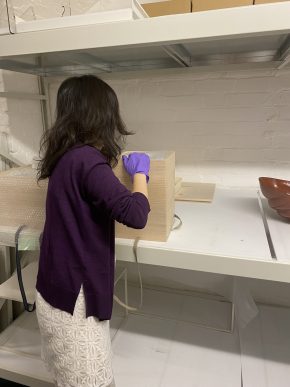
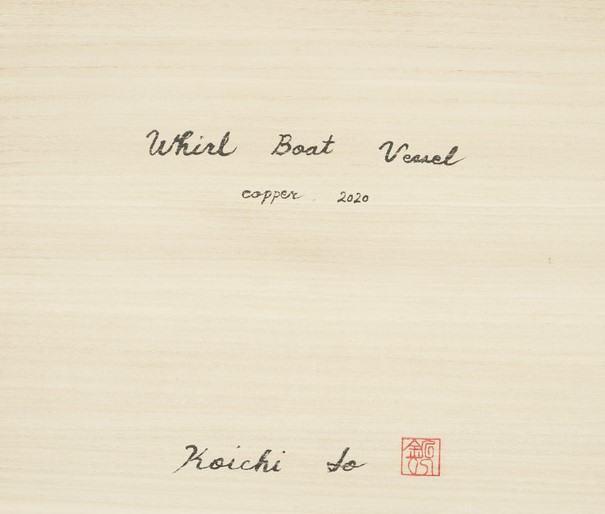
Both objects we viewed were stored in a custom-made box carefully knotted with Sanada cord (traditional decorative Japanese ribbon made from cotton). Since the Edo Period (1603 – 1867), precious objects made in Japan are often stored in such boxes to counter abrupt changes in humidity and temperature, while also reducing the risk of damage in an earthquake-prone environment. The wood from the Paulownia tree is often the material of choice, due to its natural ability to control moisture, along with its insect-repellent and fire-resistant properties. Inscriptions on the base or top of the lid are common, and often refer to what the box contains, who owns the object, when it was made, along with the maker’s signature seal or maker’s mark.
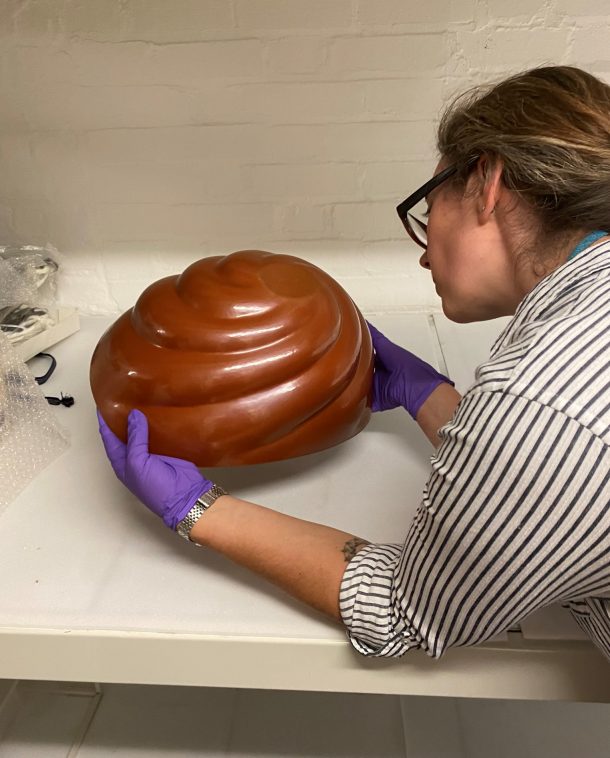
The first object we looked at was Whirl Boat Vessel by the Japanese metalsmith Koichi Io (b.1987), made in Japan in 2020. Viewing and handling this object allowed us to better understand the techniques of making and colouring it. The copper’s brilliant red coloration was achieved through a process known as ni-iro (boiled colour), whereby the metal is heated, treated in a special liquid solution to stain the metal surface, which is then covered with a protective layer of wax or lacquer. Katrina assessed the object to check its condition and to understand the surface coating of the metal, to ensure that it would not react to other objects in the display. Despite the dimensions being on the objects catalogue record, we were also surprised at the scale of the object.
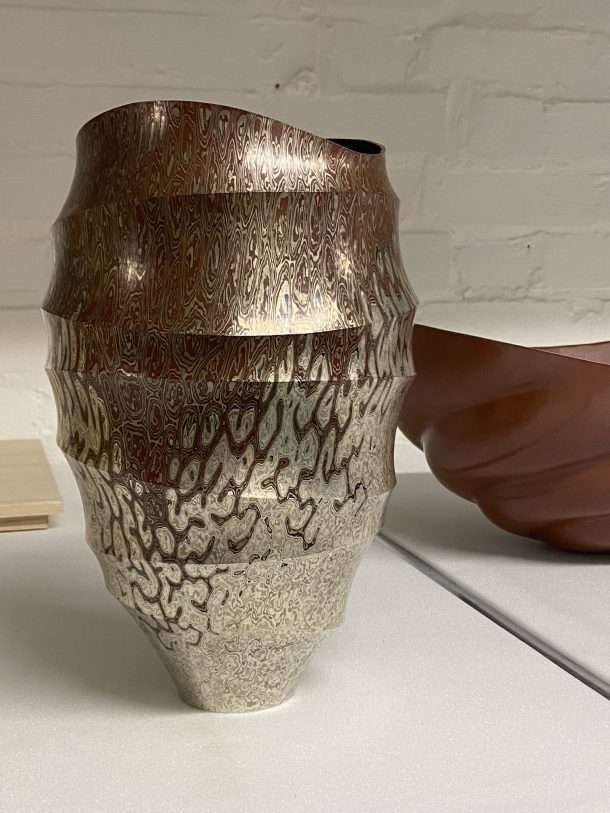
The second object we viewed was a tall vessel by Ryūhei Sako (b.1976), made in 2019. This is the only object in the display which showcases the Japanese metalworking technique known as mokume gane (wood grain metal). The contrasting colours and complex patterning, along with the immensely skilful process necessary to produce the end result makes this my personal favourite metalworking technique. Originally developed in the 17th century by Japanese metalsmiths to decorate samurai sword fittings, mokume gane is achieved by using dozens of thin sheets of metals which are fused together to form a thick wad, or ‘billet’. This billet is then rolled out into a circular sheet of metal, and with hammers, incredible skill, and a considerable amount of time, the metal is ‘stretched’ upwards and outwards, making the patterns and contrasting colours of the different metals more visible.
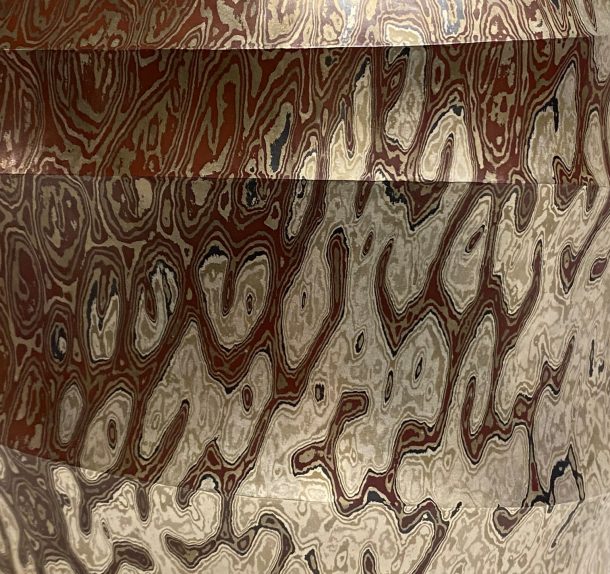
Though many patterns can be achieved, depending on the cuts made into the billet before it is rolled out, Masami commented upon the skill with which Ryūhei Sako has broken into the metal layers to create ‘a unique landscape’ and reveal the complexity of this traditional technique. Not only are such elaborate patterns difficult to achieve, but Sako has shaped the mokume gane sheet metal by raising it with hammers and various other hand tools into his desired form with incredible control, in order to create the asymmetric ridges which form the vessel’s surface.
All object viewings and condition assessments as part of the display’s development are now complete, and we are currently finalising work on the design and text for the labels. Some objects are being cleaned in conservation and we are getting ready to install the display in the coming weeks. I hope you’ve enjoyed this taster and will come to see the display once it opens in November to discover the extraordinary craft and skill of metalsmiths today.
Metalworking Now will open in Room 66 of the Silver Galleries at the V&A South Kensington on Saturday 12 November and is free to visit.
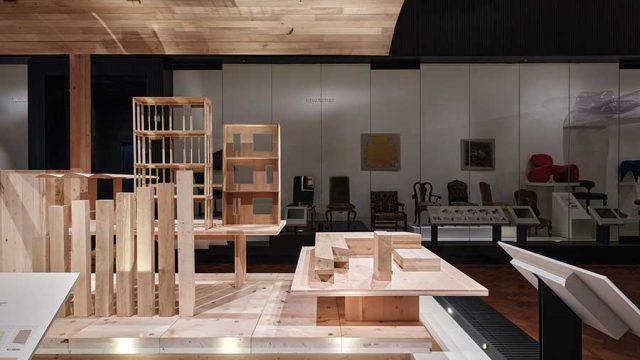
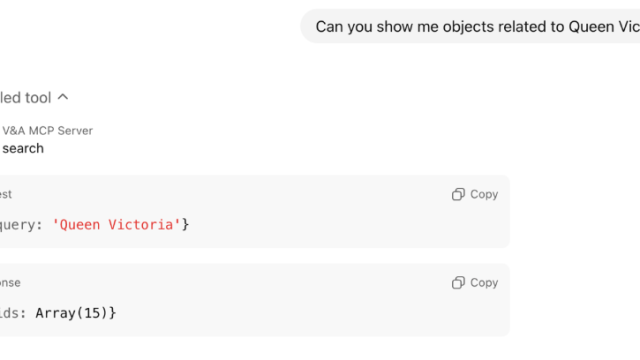
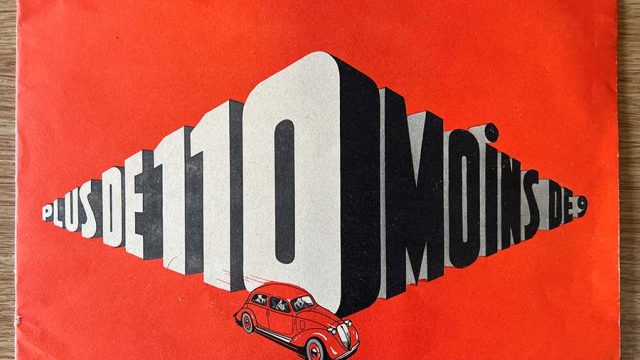
Thanks for explaining the process of display preparation for such objects, and for sharing details on two such beautiful examples. I’m really looking forward to seeing this display – those on metalwork are always eye-opening and memorable.